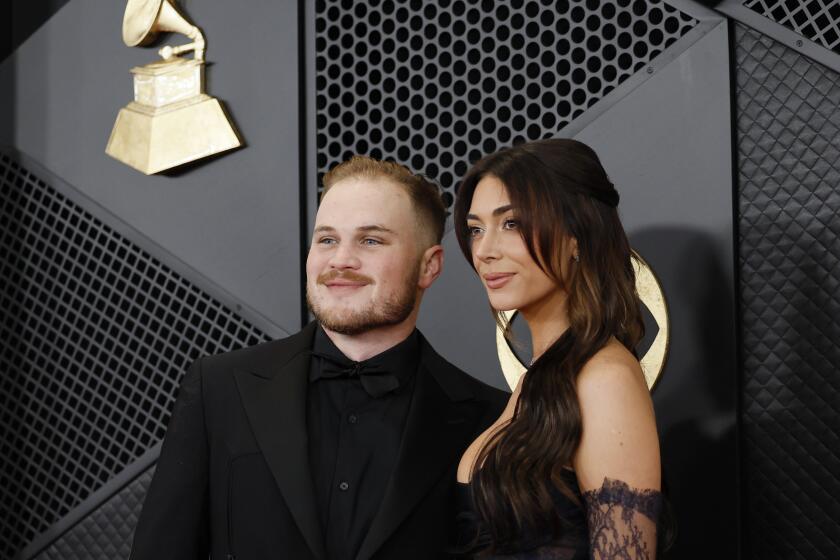Recording Academy merges organizations in expansion of Grammy Museum programming
On a recent Friday evening, L.A. Live was thick with action.
Music blared from a DJ booth as guests filed into the Microsoft Theater for an ESPN event. A casual basketball game was in full swing in the courtyard and jersey-clad Lakers fans descended upon the downtown complex.
For the record:
1:42 p.m. Nov. 27, 2024An earlier version of this article stated that the Grammy Museum and the Grammy Foundation had collectively served nearly 100,000 students during their lifetimes. That number is for 2016 alone.
Calmer was the Grammy Museum, L.A. Liveâs headquarters for the history of pop music.
Behind the scenes, however, executives have been working to transform the museum from a palace of interactive exhibits, artifacts and intimate concerts into a leading educational institution.
The Museum aims to expand its programming in a merger with the Recording Academyâs Grammy Foundation, bringing it closer to one of the charitable arms affiliated with the institution responsible for the yearly Grammy Awards.
The combined entity will be re-branded the Grammy Museum Foundation.
âWhen you look at what the mission of the Grammy Foundation was in its inception and the missions of the [museum] ⌠there are a lot of goals and aspirations that are in alignment,â the Recording Academyâs president, Neil Portnow, said ahead of Mondayâs announcement. Chief among them: Both institutions pair students with music professionals, and the Grammy Foundation funds museum-like preservation efforts.
When the Grammy Museum launched in 2008, it did so with a 10-year financial commitment from AEG. A museum spokeswoman says AEG will continue to be âa significant resource for the ongoing financial stability of the museumâ under the new structure.
âWeâve put ourselves in a position where weâre trying to create as much money as possible to do even more exhibits and expand its footprint outside of Los Angeles,â said Todd Goldstein, AEGâs chief revenue officer.
When the $34-million institution opened to the public, it faced an uphill battle; tax documents show it has continued to struggle to operate without a deficit.
The museum opened before many properties that now thrive in the complex, when foot traffic was scarce and the Great Recession resulted in cuts during its first year.
The newly expanded Grammy Museum Foundation was largely spearheaded by the museumâs excecutive director Bob Santelli, who will now assume the title of founding executive director and focus on domestic and international expansions. Scott Goldman, previously vice president of the Grammy Foundation and the Recording Academyâs MusiCares Foundation, will serve as executive director of the Grammy Museum.
Executives credit successes beyond L.A. â being selected by the White House to co-produce concerts and working with then-First Lady Michelle Obama on music education programs, for example â with catapulting the museumâs profile.
The museum, which is heavy on interactive exhibits, attracts about 135,000 visitors a year.
Of course, Santelli would welcome more visitors. âBut,â he said, âthe museum is designed for a lot of one-on-one experiences ⌠so that requires it to be a successful, smaller visitation than some of the big museums.â
âItâs not intended to be the cash cow,â Portnow offered. âIt is about creating a cultural institution.â
Aligning with the Grammy Foundation â which oversees the Recording Academyâs education and preservation efforts â will allow the museum to focus on expanding its curriculum-based initiatives.
âThe combined efforts of both will achieve a level of scale, prominence and impact where the sum is greater than the parts,â said Portnow.
At a time when federal funding for the arts is imperiled, Grammy executives see doubling down on education as vital.
In the last year, the Grammy Foundation provided $300,000 in grants to facilitate research, archiving and preservation projects. In 2016 alone, the museum and foundation have collectively served nearly 100,000 students.
âItâs time to move away from the things that have felt good and have been traditional but really arenât moving the needle,â said Portnow, who hopes to see âa more vibrant, more meaningful approach to music education.
âItâs important, especially when all of this is so much under fire â and in certain cases under attack on a governmental level.â
See the most-read stories in Entertainment this hour Âť
For more music news follow me on Twitter:@GerrickKennedy
More to Read
The biggest entertainment stories
Get our big stories about Hollywood, film, television, music, arts, culture and more right in your inbox as soon as they publish.
You may occasionally receive promotional content from the Los Angeles Times.











